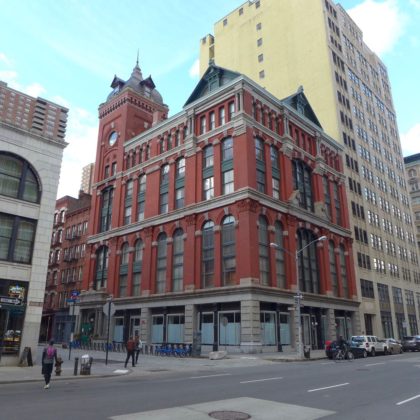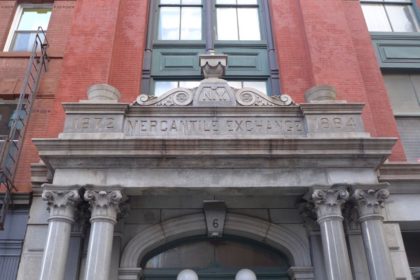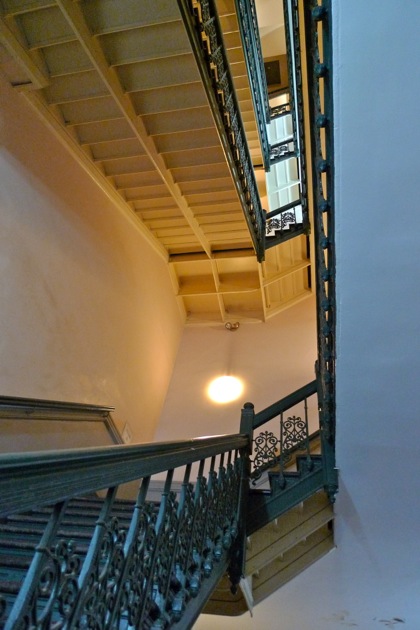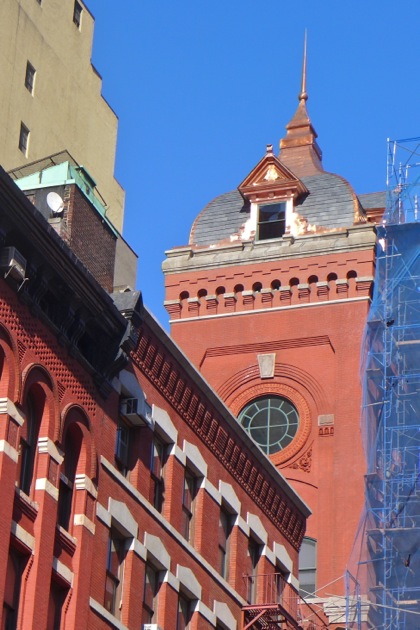The History of 2-6 Harrison
 Tom Miller, who writes about the history of Manhattan buildings at Daytonian in Manhattan, has allowed Tribeca Citizen to create a database of his Tribeca posts. If you enjoy these, and you will, then you should definitely check out his website, which also has write-ups about buildings all over the island. And don’t miss his book, Seeking New York: The Stories Behind the Historic Architecture of Manhattan—One Building at a Time.
Tom Miller, who writes about the history of Manhattan buildings at Daytonian in Manhattan, has allowed Tribeca Citizen to create a database of his Tribeca posts. If you enjoy these, and you will, then you should definitely check out his website, which also has write-ups about buildings all over the island. And don’t miss his book, Seeking New York: The Stories Behind the Historic Architecture of Manhattan—One Building at a Time.
··································
 In the middle of the 19th century, buyers and sellers of various commodities recognized the need to organize in order to maintain quality and standards, to eliminate questionable practices and set down rules of doing business. Among the several “exchanges” was the Butter and Cheese Exchange of New York, formed in 1872 when the dairy men broke off from the Produce Exchange.
In the middle of the 19th century, buyers and sellers of various commodities recognized the need to organize in order to maintain quality and standards, to eliminate questionable practices and set down rules of doing business. Among the several “exchanges” was the Butter and Cheese Exchange of New York, formed in 1872 when the dairy men broke off from the Produce Exchange.
The new exchange quickly broadened its base, admitting the egg trade soon after (and changing the name to the Butter, Cheese and Egg Exchange), then including dried fruits, poultry and canned goods in 1882 when the name was changed again to the all-inclusive New York Mercantile Exchange.
Three years later, in 1885, grocers were admitted to the exchange. By now there were 801 members and as additional trades were added, the membership was limited to 1000 with an initiation fee of $500. The growth demanded a larger space to conduct business and land was purchased from the Trinity Corporation at the corner of Harrison and Hudson Streets for a new building.
Architect Thomas R. Jackson was commissioned to design the new exchange. Jackson, who had been head draftsman under Richard Upjohn, created a five-story red brick Queen Anne style building with an imposing off-set tower over the Harrison Street entrance. The finished structure cost $400,000. Rusticated granite pillars, terra cotta Corinthian capitols on brick pilasters and carved stone ornamentation combined with gables paired stone columns on the fifth floor and picturesque dormers in the tower’s mansard cap created a visual feast.
 On the evening of April 6, 1886, invited guests toured the new building. While the 7th Regiment Band played music from “The Merry Wives of Windsor,” over 800 well-dressed ladies and gentlemen alit from carriages. The New York Times remarked that “The decorator’s art was taxed to beautify the galleries with graceful hangings in velvet and spangles.” After the guests had toured the building the maple floor of the hall was given over to dancing, inciting The Times to note that “a good many feet were set in motion during the latter part of the evening.”
On the evening of April 6, 1886, invited guests toured the new building. While the 7th Regiment Band played music from “The Merry Wives of Windsor,” over 800 well-dressed ladies and gentlemen alit from carriages. The New York Times remarked that “The decorator’s art was taxed to beautify the galleries with graceful hangings in velvet and spangles.” After the guests had toured the building the maple floor of the hall was given over to dancing, inciting The Times to note that “a good many feet were set in motion during the latter part of the evening.”
The upper three floors of the building were leased to other businesses for offices, the Hooven Mercantile company leasing space here in 1911.
When an investigation into possible control of egg and dairy products prices and subsequent monopolies arose in 1916, Julius D. Mahr, the President of the Exchange was aghast. “The investigation on which that allegation is made does not show the bitter competition that exists in the butter and egg business,” he stressed. “Why, those twenty men are all the time willing to cut one another’s throats. It’s a question of dog eat dog, that is by the day. Of course, after business is over, they are the best of friends at night.”
On July 5, 1922, tragedy struck at the Exchange when commission merchant Herman Ettinger spoke to friends of financial worries and debts owed him by his customers. Ettinger cleared his business for the day, telephoned a friend saying, “You will never see me again,” wrote a note asking that his wife, Ella, be notified as “gently as possible,” then shot himself with a pistol in his office.
 By 1939, the Exchange was the trading center for 7,500,000 cases of eggs and 3,500,000 tubs of butter every year. Business was conducted throughout most of the 20th century here; with a high-speed ticker system being installed in 1972, the year of the Exchange’s Centennial. That year The Times remarked on the wide variety of commodities being exchanged. The old building was, it said, “where futures in Maine potatoes, platinum, United States silver coins, imported boneless beef and palladium are traded.”
By 1939, the Exchange was the trading center for 7,500,000 cases of eggs and 3,500,000 tubs of butter every year. Business was conducted throughout most of the 20th century here; with a high-speed ticker system being installed in 1972, the year of the Exchange’s Centennial. That year The Times remarked on the wide variety of commodities being exchanged. The old building was, it said, “where futures in Maine potatoes, platinum, United States silver coins, imported boneless beef and palladium are traded.”
In 1994, the New York Mercantile Exchange, by now called NYMEX, merged with COMEX and left the venerable old brick building, moving to a new trading facility and office downtown. For a period the building was home to Local 1180 of the Communications Workers of America. Today the structure has been sensitively converted into condominiums with a restaurant on the ground floor.
 ··································
··································
Photo credits: Tribeca Citizen.













